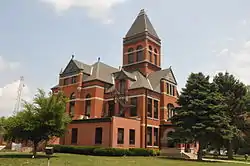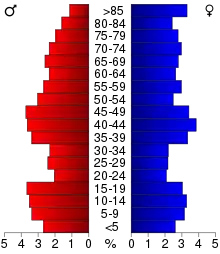Monona County | |
|---|---|
 | |
 Location within the U.S. state of Iowa | |
 Iowa's location within the U.S. | |
| Coordinates: 42°02′50″N 95°58′07″W / 42.047222222222°N 95.968611111111°W | |
| Country | |
| State | |
| Founded | 1851 |
| Seat | Onawa |
| Largest city | Onawa |
| Area | |
| • Total | 699 sq mi (1,810 km2) |
| • Land | 694 sq mi (1,800 km2) |
| • Water | 4.9 sq mi (13 km2) 0.7% |
| Population (2020) | |
| • Total | 8,751 |
| • Density | 13/sq mi (4.8/km2) |
| Time zone | UTC−6 (Central) |
| • Summer (DST) | UTC−5 (CDT) |
| Congressional district | 4th |
| Website | www |
Monona County is a county located in the U.S. state of Iowa. As of the 2020 census, the population was 8,751.[1] The county seat is Onawa.[2][3]
History
The area around present-day Onawa was a stopping point in 1804 for Meriwether Lewis and William Clark during their exploration of the newly obtained Louisiana Purchase. Many years later, that site was memorialized as the Lewis and Clark State Park.[4]
Monona County was formed in 1851. It was perhaps named for an Indian word meaning "beautiful valley."[5]
Monona County was organized officially in the spring of 1854 having been a part of Benton County (every county west of Benton in a line) in 1851 and afterwards Harrison County between 1852 and 1854.[6]
When Ashton (originally called Bloomfield) was named the county seat in the fall of 1854, a log house served as the first courthouse.[7] Ashton remained the county seat for only four years. That designation was moved to Onawa on April 5, 1858, and the first Monona County Courthouse was completed that same year.[8]
Geography
According to the U.S. Census Bureau, the county has a total area of 699 square miles (1,810 km2), of which 694 square miles (1,800 km2) is land and 4.9 square miles (13 km2) (0.7%) is water.[9]
Major highways
Adjacent counties
- Woodbury County (north)
- Crawford County (east)
- Harrison County (south)
- Burt County, Nebraska (southwest)
- Thurston County, Nebraska (west)
Demographics
| Census | Pop. | Note | %± |
|---|---|---|---|
| 1860 | 832 | — | |
| 1870 | 3,654 | 339.2% | |
| 1880 | 9,055 | 147.8% | |
| 1890 | 14,515 | 60.3% | |
| 1900 | 17,980 | 23.9% | |
| 1910 | 16,633 | −7.5% | |
| 1920 | 17,125 | 3.0% | |
| 1930 | 18,213 | 6.4% | |
| 1940 | 18,238 | 0.1% | |
| 1950 | 16,303 | −10.6% | |
| 1960 | 13,916 | −14.6% | |
| 1970 | 12,069 | −13.3% | |
| 1980 | 11,692 | −3.1% | |
| 1990 | 10,034 | −14.2% | |
| 2000 | 10,020 | −0.1% | |
| 2010 | 9,243 | −7.8% | |
| 2020 | 8,751 | −5.3% | |
| U.S. Decennial Census[10] 1790-1960[11] 1900-1990[12] 1990-2000[13] 2010-2018[14] | |||

2020 census
The 2020 census recorded a population of 8,751 in the county, with a population density of 12.5221/sq mi (4.83481/km2). 96.03% of the population reported being of one race. 90.33% were non-Hispanic White, 0.32% were Black, 2.70% were Hispanic, 1.67% were Native American, 0.32% were Asian, 0.02% were Native Hawaiian or Pacific Islander and 4.64% were some other race or more than one race. There were 4,373 housing units, of which 3,839 were occupied.[1]
2010 census
The 2010 census recorded a population of 9,243 in the county, with a population density of 13.3354/sq mi (5.14881/km2). There were 4,697 housing units, of which 4,050 were occupied.[15]
2000 census

As of the census[16] of 2000, there were 10,020 people, 4,211 households, and 2,737 families residing in the county. The population density was 14 people per square mile (5.4 people/km2). There were 4,660 housing units at an average density of 7 units per square mile (2.7 units/km2). The racial makeup of the county was 98.34% White, 0.08% Black or African American, 0.76% Native American, 0.12% Asian, 0.04% Pacific Islander, 0.08% from other races, and 0.58% from two or more races. 0.70% of the population were Hispanic or Latino of any race.
There were 4,211 households, out of which 26.70% had children under the age of 18 living with them, 54.50% were married couples living together, 7.10% had a female householder with no husband present, and 35.00% were non-families. 31.00% of all households were made up of individuals, and 17.50% had someone living alone who was 65 years of age or older. The average household size was 2.31 and the average family size was 2.88.
In the county, the population was spread out, with 23.20% under the age of 18, 6.20% from 18 to 24, 23.30% from 25 to 44, 23.30% from 45 to 64, and 23.90% who were 65 years of age or older. The median age was 43 years. For every 100 females, there were 94.20 males. For every 100 females age 18 and over, there were 90.50 males.
The median income for a household in the county was $33,235, and the median income for a family was $41,172. Males had a median income of $27,349 versus $19,607 for females. The per capita income for the county was $17,477. About 6.60% of families and 9.40% of the population were below the poverty line, including 8.90% of those under age 18 and 9.50% of those age 65 or over.
Communities
Unincorporated communities
Ticonic
Townships
Population ranking
The population ranking of the following table is based on the 2020 census of Monona County.[1]
† county seat
| Rank | City/Town/etc. | Population (2020 Census) |
|---|---|---|
| 1 | † Onawa | 2,906 |
| 2 | Mapleton | 1,165 |
| 3 | Whiting | 745 |
| 4 | Ute | 338 |
| 5 | Blencoe | 233 |
| 6 | Moorhead | 199 |
| 7 | Soldier | 184 |
| 8 | Castana | 107 |
| 9 | Turin | 72 |
| 10 | Rodney | 45 |
Politics
For over a century, Monona County was close to a national bellwether. Between 1900 & 2004, it only failed to back the national winner in 1960 & 1988. However, this bellwether status no longer applies. Barack Obama failed to carry the county in both of his electoral victories statewide & nationally, while Donald Trump in 2020 earned the highest percentage of any candidate since Franklin D. Roosevelt in 1932, in spite of his unsuccessful reelection bid.
| Year | Republican | Democratic | Third party | |||
|---|---|---|---|---|---|---|
| No. | % | No. | % | No. | % | |
| 2020 | 3,248 | 68.70% | 1,407 | 29.76% | 73 | 1.54% |
| 2016 | 3,120 | 68.24% | 1,247 | 27.27% | 205 | 4.48% |
| 2012 | 2,557 | 53.92% | 2,101 | 44.31% | 84 | 1.77% |
| 2008 | 2,411 | 50.26% | 2,295 | 47.84% | 91 | 1.90% |
| 2004 | 2,575 | 51.32% | 2,397 | 47.77% | 46 | 0.92% |
| 2000 | 2,304 | 50.53% | 2,086 | 45.75% | 170 | 3.73% |
| 1996 | 1,674 | 39.50% | 1,952 | 46.06% | 612 | 14.44% |
| 1992 | 1,660 | 34.23% | 1,939 | 39.99% | 1,250 | 25.78% |
| 1988 | 2,068 | 46.05% | 2,408 | 53.62% | 15 | 0.33% |
| 1984 | 2,746 | 55.37% | 2,159 | 43.54% | 54 | 1.09% |
| 1980 | 3,268 | 61.85% | 1,660 | 31.42% | 356 | 6.74% |
| 1976 | 2,636 | 49.09% | 2,661 | 49.55% | 73 | 1.36% |
| 1972 | 3,237 | 58.91% | 2,189 | 39.84% | 69 | 1.26% |
| 1968 | 2,980 | 53.12% | 2,184 | 38.93% | 446 | 7.95% |
| 1964 | 2,208 | 35.69% | 3,971 | 64.18% | 8 | 0.13% |
| 1960 | 3,863 | 54.64% | 3,207 | 45.36% | 0 | 0.00% |
| 1956 | 3,854 | 52.47% | 3,477 | 47.34% | 14 | 0.19% |
| 1952 | 4,849 | 62.29% | 2,918 | 37.49% | 17 | 0.22% |
| 1948 | 3,179 | 43.28% | 4,098 | 55.79% | 69 | 0.94% |
| 1944 | 3,583 | 48.64% | 3,761 | 51.06% | 22 | 0.30% |
| 1940 | 4,192 | 46.63% | 4,783 | 53.20% | 15 | 0.17% |
| 1936 | 3,008 | 35.39% | 5,346 | 62.89% | 146 | 1.72% |
| 1932 | 2,181 | 27.92% | 5,537 | 70.88% | 94 | 1.20% |
| 1928 | 3,745 | 56.55% | 2,836 | 42.82% | 42 | 0.63% |
| 1924 | 3,195 | 50.94% | 1,271 | 20.26% | 1,806 | 28.79% |
| 1920 | 4,569 | 69.49% | 1,960 | 29.81% | 46 | 0.70% |
| 1916 | 1,777 | 47.87% | 1,910 | 51.45% | 25 | 0.67% |
| 1912 | 1,109 | 29.00% | 1,358 | 35.51% | 1,357 | 35.49% |
| 1908 | 1,977 | 52.58% | 1,732 | 46.06% | 51 | 1.36% |
| 1904 | 2,274 | 64.80% | 1,016 | 28.95% | 219 | 6.24% |
| 1900 | 2,161 | 51.53% | 1,934 | 46.11% | 99 | 2.36% |
| 1896 | 1,526 | 36.86% | 2,558 | 61.79% | 56 | 1.35% |
See also
References
- 1 2 3 "2020 Census State Redistricting Data". census.gov. United states Census Bureau. Retrieved August 12, 2021.
- ↑ "Find a County". National Association of Counties. Retrieved June 7, 2011.
- ↑ Monona County Economic Development Partnership for Growth
- ↑ About Monona County
- ↑ Monona County Archived July 3, 2007, at archive.today
- ↑ History of Monona County, Iowa: Containing Full-page Portraits and Biographical Sketches of Prominent and Representative Citizens of the County, Together with Portraits and Biographies of All the Governors of Iowa, and of the Presidents of the United States. National Publishing Company. 1890. pp. 166 .
- ↑ "Excerpt from: "The Counties and Courthouses of Iowa"". Archived from the original on April 5, 2016. Retrieved April 30, 2016.
- ↑ History of Western Iowa, Its Settlement and Growth. Western Publishing Company. 1882. pp. 249.
- ↑ "US Gazetteer files: 2010, 2000, and 1990". United States Census Bureau. February 12, 2011. Retrieved April 23, 2011.
- ↑ "U.S. Decennial Census". United States Census Bureau. Retrieved July 20, 2014.
- ↑ "Historical Census Browser". University of Virginia Library. Retrieved July 20, 2014.
- ↑ "Population of Counties by Decennial Census: 1900 to 1990". United States Census Bureau. Retrieved July 20, 2014.
- ↑ "Census 2000 PHC-T-4. Ranking Tables for Counties: 1990 and 2000" (PDF). United States Census Bureau. Archived (PDF) from the original on March 27, 2010. Retrieved July 20, 2014.
- ↑ "State & County QuickFacts". United States Census Bureau. Archived from the original on June 7, 2011. Retrieved July 20, 2014.
- ↑ "Population & Housing Occupancy Status 2010" (PDF). United States Census Bureau – American FactFinder. Archived (PDF) from the original on October 16, 2020. Retrieved August 15, 2022.
- ↑ "U.S. Census website". United States Census Bureau. Retrieved January 31, 2008.
- ↑ Leip, David. "Dave Leip's Atlas of U.S. Presidential Elections". uselectionatlas.org. Retrieved April 27, 2018.
External links
- Discover Monona County Portal style website, The Communities, Recreation and more
- Monona County website